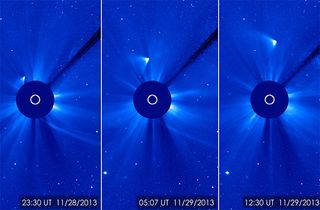Ace Solar Observatory to Make 3,000th Comet Discovery

SOHO wasn't meant to search for comets. That's clear even in its name, which stands for the Solar and Heliospheric Observatory; it was designed to study the heliosphere, or the sun's extended atmosphere.
But in nearly 20 years of gazing at the sun, the joint NASA and European Space Agency mission has served as an accidental spy for comets on a death plunge -- Comet Lovejoy (in 2011), Comet ISON (in 2013) and nearly 3,000 others.
PHOTOS: The Psychedelic Anatomy of a Solar Flare
The unofficial count as of Monday morning (Aug. 17) is in the low 2,990s, Karl Battams told Discovery News. Battams is the sungrazer project co-ordinator at the Naval Research Laboratory and works on many missions, including SOHO. He estimates that the 3,000th comet will be found in the next couple of weeks.
"The overwhelming majority (of comets) have been found by amateur astronomers in their spare time; it is a volunteering effort on their part," Battams said, adding that five or six people have together discovered roughly one-third of SOHO's comets. These volunteers scour SOHO's site for new pictures. The rules are that all comets are named after SOHO, but Battams and others acknowledge the volunteer efforts in publications.
ANALYSIS: Black Hole Hunter Probes Our Psychedelic X-Ray Sun
What makes SOHO unique among sun-gazing spacecraft is its coronograph (an instrument including an occulter that blocks out the sun's glare) is directly in the line between the Earth and the sun, allowing for a perfect view of sungrazing comets.
Get the Space.com Newsletter
Breaking space news, the latest updates on rocket launches, skywatching events and more!
Most of them hail from a single group known as Kreutz comets, which are likely fragments of a huge comet that broke up in 1106. Kreutz comets have an extremely short perihelion (distance to the sun); due to their tiny size and closeness to the sun, only one comet has survived a scorching close-pass in SOHO's observations -- and that 2011 comet, Lovejoy, broke up within two weeks.
SOHO remains in excellent operational shape and has enough fuel on board to last for decades, Battams added. The 2016 NASA budget request asked for $2.2 million in funding annually for SOHO through 2020, out of a total budget request of $18.6 billion in 2016.
PHOTOS: Meet Rosetta's Beautiful Lumpy Comet
Partner European Space Agency is prepared to stay on board for at least a few more years, Battams said. But a successor comet-hunting mission isn't on the books, at least yet.
"It is unique and extremely valuable," Battams said. "It's operating now at really low cost; they've managed to scrape by not on pennies, but figuratively speaking they have done it. My own speculation is they will continue funding it for as long as its operational, or until it gets replaced by something else."
This article was provided by Discovery News.
Join our Space Forums to keep talking space on the latest missions, night sky and more! And if you have a news tip, correction or comment, let us know at: community@space.com.

Elizabeth Howell (she/her), Ph.D., is a staff writer in the spaceflight channel since 2022 covering diversity, education and gaming as well. She was contributing writer for Space.com for 10 years before joining full-time. Elizabeth's reporting includes multiple exclusives with the White House and Office of the Vice-President of the United States, an exclusive conversation with aspiring space tourist (and NSYNC bassist) Lance Bass, speaking several times with the International Space Station, witnessing five human spaceflight launches on two continents, flying parabolic, working inside a spacesuit, and participating in a simulated Mars mission. Her latest book, "Why Am I Taller?", is co-written with astronaut Dave Williams. Elizabeth holds a Ph.D. and M.Sc. in Space Studies from the University of North Dakota, a Bachelor of Journalism from Canada's Carleton University and a Bachelor of History from Canada's Athabasca University. Elizabeth is also a post-secondary instructor in communications and science at several institutions since 2015; her experience includes developing and teaching an astronomy course at Canada's Algonquin College (with Indigenous content as well) to more than 1,000 students since 2020. Elizabeth first got interested in space after watching the movie Apollo 13 in 1996, and still wants to be an astronaut someday. Mastodon: https://qoto.org/@howellspace
